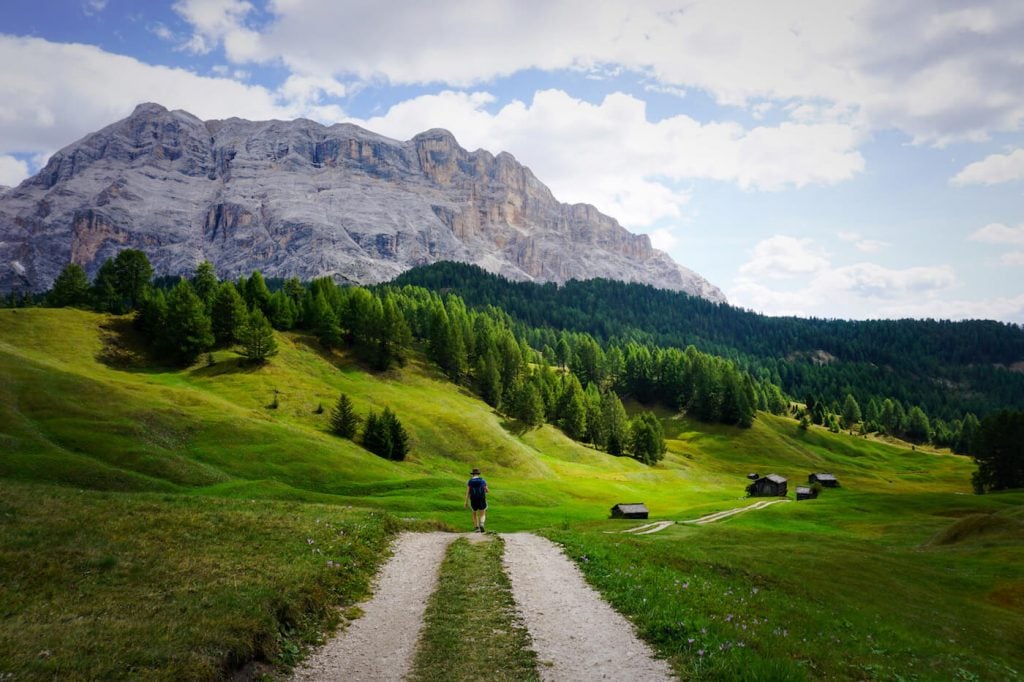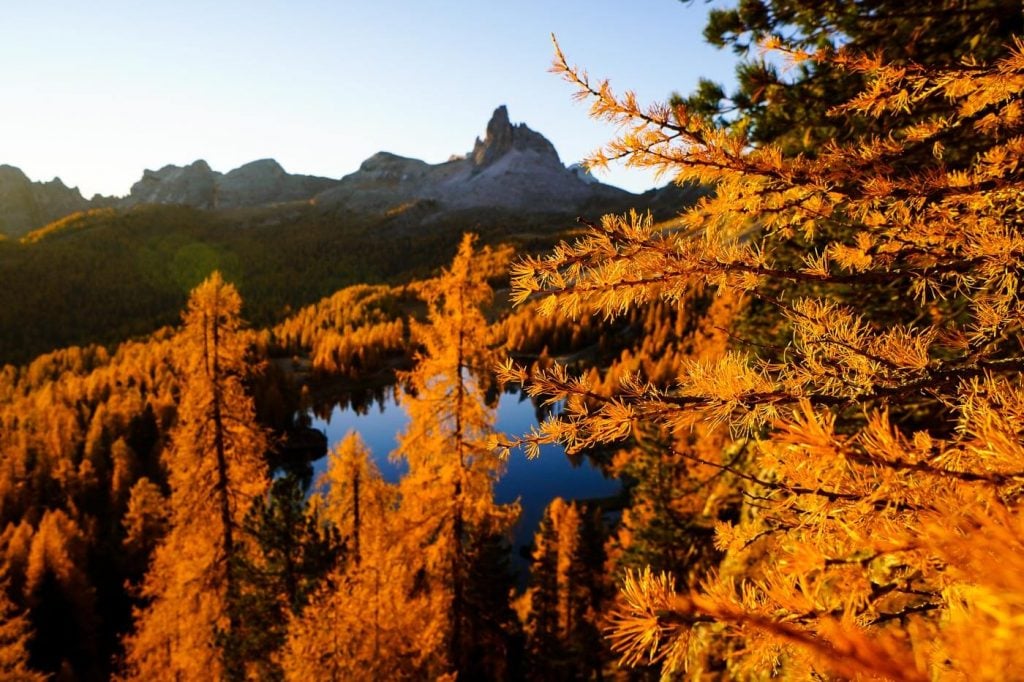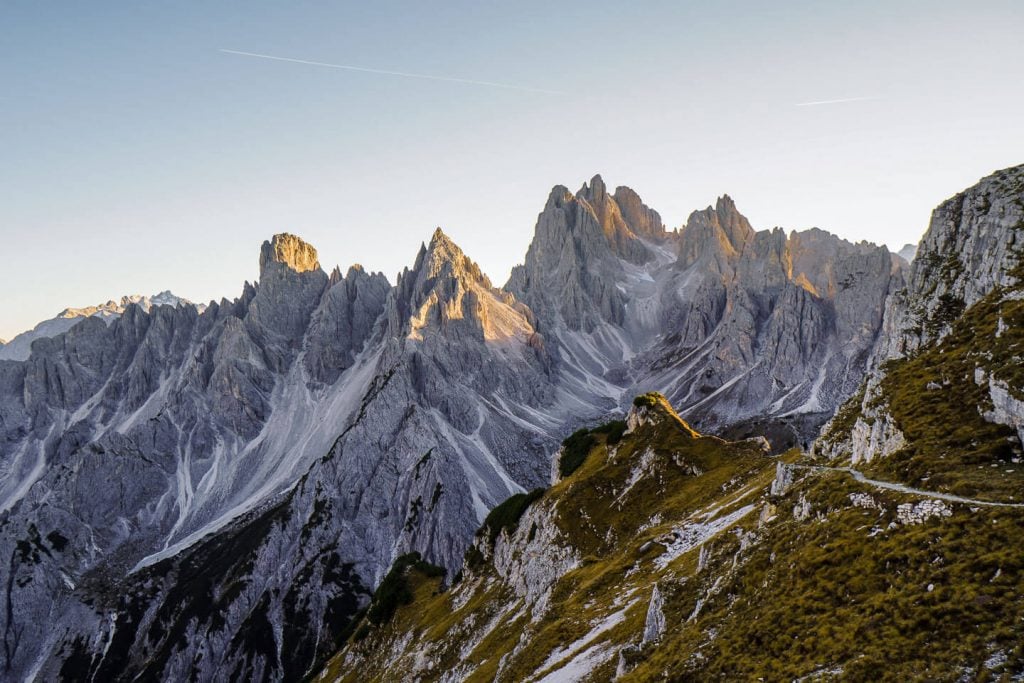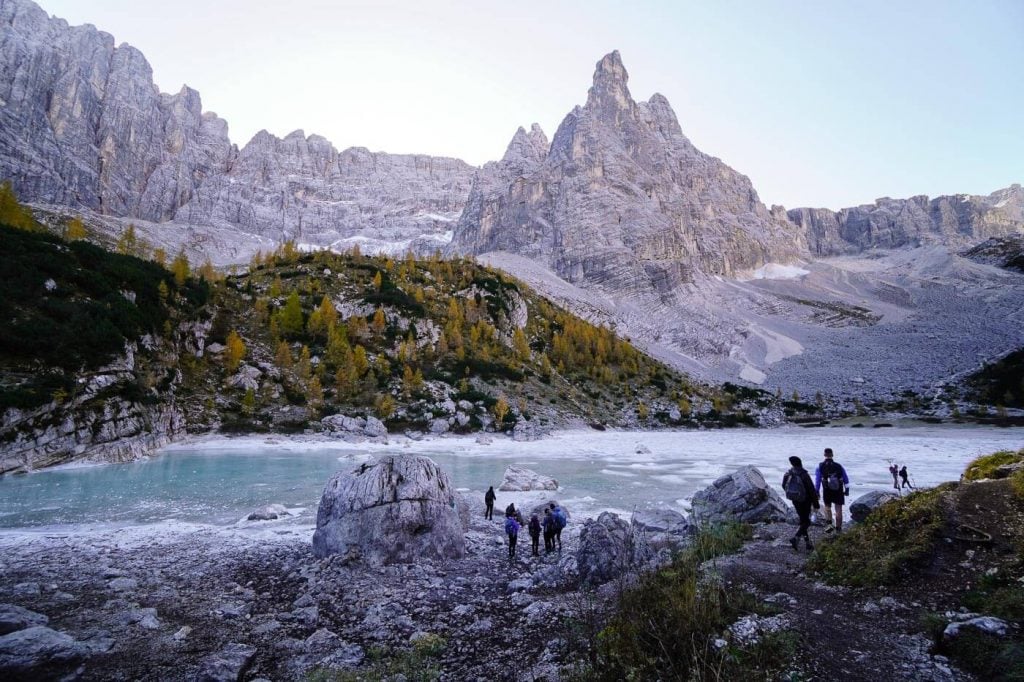20 Best Places to Visit in the Dolomites in 2025 (+ Map) (original) (raw)
The Italian Dolomites are home to some of the most arresting mountains, valleys, and lakes in the European Alps. At every turn, you’ll be bewitched by the craggy peaks, velvet-like meadows, and thrilling mountain passes that define this sub-range of the Southern Limestone Alps.
Visit the Dolomites and your days will be filled with unforgettable “am I dreaming?” moments. From the spectacular scenery and hiking trails to the charming mountainside huts and excellent hotels, the Dolomites will exceed your expectations (in every possible way).
The most popular destinations in the Dolomites are fanned out across the Northern Italian provinces of South Tyrol, Trentino and Belluno.
The best way to see the top Dolomites attractions is by dividing your time equally between two or three baes: Cortina d’Ampezzo, Alta Pusteria (Dobbiaco, San Candido, Sesto, or Braies), San Martino di Castrozza, Val Gardena(Ortisei, Selva di Val Gardena, or Santa Cristina),andAlta Badia(Colfosco, Corvara, La Villa, Badia, or San Cassiano).
In this roundup of best places to visit in the Dolomites, we’ll help you decide what to see and where to go in the Dolomites.
If you’re curious about what to do, read Unforgettable Things to Do in the Dolomites (via ferrata climbing, hut to hut hiking, etc…).
If you’re trying to figure out which villages and towns to stay in, read Where to Stay in the Dolomites.
- Dolomites Destinations Map
- 1. Lago di Braies
- 2. Prato Piazza
- 3. Val Fiscalina
- 4. Alpe di Siusi
- 5. Seceda
- 6. Val di Funes
- 7. Passo delle Erbe
- 8. Passo Gardena
- 9. Puez-Odle Nature Park
- 10. Armentara Meadows
- 11. Cortina d’Ampezzo
- 12. Lago Federa
- 13. Tre Cime di Lavaredo
- 14. Cadini di Misurina
- 15. Lago di Sorapis
- 16. Mondeval Plateau
- 17. San Martino di Castrozza
- 18. Altopiano delle Pale di San Martino
- 19. Val Venegia
- 20. Baita Segantini
- Dolomites Trip Planning Essentials

- Italian Regions: Trentino-Alto Adige, Veneto, and Friuli Venezia Giulia
- Languages Spoken: Italian, Ladin, and German
- How Much Time Do You Need: 5 days – 14 days
- Dolomites Itineraries: 5 Day Dolomites Itinerary, 7 Day Dolomites Road Trip Itinerary, and 10-14 Day Dolomites Road Trip
- Closest Airports: Bolzano Airport and Marco Polo International Airport, Venice, Italy
- Summer Season: June – late October
- Winter Season: December – early April
- When Not to Visit: November and May
- Accommodation Options: Apartments, farm stays, mountain huts, guesthouses, hotels, and campgrounds. Wild camping is not allowed. Learn more in our Dolomites Accommodation guide.
Dolomites Destinations Map
1. Lago di Braies

Lago di Braies(Pragser Wildsee) is a stunning lake at the foot of Croda del Becco/Seekofel in Valle di Braies/Pragser Tal, a side valley of Alta Pusteria/Pustertal in South Tyrol.
The best time of year to visit Lago di Braies is early in the summer (June) or in the fall (late September – October). As the summer season progresses, the water level decreases.
Lago di Braies is usually the first place people want to see in the Dolomites. In high season, it’s a zoo. Most people just come for the photo. Many will walk the circuit trail around the lake. But, the smartest people visit Lago di Braies at sunrise and hike to the summits of surrounding peaks, like Hochalpenkopf.
Did you know that Lago di Braies is the starting point of the Alta Via 1 long distance trail?
Braies Valley Accommodations | Garni Bergblick (budget), Berggasthaus Agritur Moserhof (budget-midrange), and Farmhouse Hanslerhof (midrange)
2. Prato Piazza

Prato Piazza (Plätzwiese) plateau is a high alpine pasture above Valle di Braies/Pragser Tal, not too far from Lago di Braies. The plateau lies between Picco di Vallandro/Dürrenstein (2839 m) and Monte Croda Rossa d’Ampezzo/Hohe Gaisl (3146 m) in Fanes-Sennes-Braies Nature Park.
The most popular thing to do on Prato Piazza is to hike to the panoramic summit of Monte Specie/Strudelkopf. From this easy-to-reach peak, you’ll be treated to marvelous views of Tre Cime di Lavaredo, Cadini di Misurina, and the Cristallo Group.
Our favorite hiking trail starting on Prato Piazza runs along the northern slopes and cirques of the Croda Rossa d’Ampezzo/Hohe Gaisl massif to Malga Rossalm. This Gaisl High Trail is moderate, but requires a head for heights and comfort with light exposure.
Braies Valley Accommodations | Garni Bergblick (budget), Berggasthaus Agritur Moserhof (budget-midrange), and Farmhouse Hanslerhof (midrange)
3. Val Fiscalina

Val Fiscalina/Fischleintal is a gorgeous side-valley of Sesto/Sexten Valley in South Tyrol. It serves as a gateway to the northern Sexten Dolomites and the Three Peaks Nature Park.
For a low-key adventure, hike the Val Fiscalina valley trail, starting at Bad Moos and ending at Rifugio Fondovalle/Talschlusshütte. You can also start the valley walk in the town of Sesto/Sexten.
From Rifugio Gondovalle, you can continue ascending Valle Sasso Vecchio/Altensteintal valley all the way up Rifugio Locatelli/Dreizinnenhütte (2405 m) and Tre Cime di Lavaredo/Drei Zinnen. That’s how we started this easy-moderate 3-day hut-to-hut hike.
There are two excellent hotels in Val Fiscalina you should know about: Bad Moos Dolomites Spa Resort and the historic Hotel Dolomitenhof.
Learn More: How to Visit Val Fiscalina
4. Alpe di Siusi

Alpe di Siusi (Seiser Alm in German, Mont Sëuc in Ladin) is the largest high-alpine pasture in Europe, covering a surface area of 56 square kilometers. This rolling alpine plateau stretches from the foot of the Sassolungo Group (Langkofel) to the base of Sciliar (Schlern) in South Tyrol.
Alpe di Siusi is a magnet for photographers as well as hikers, cyclists, and skiers. You can access the plateau easily by gondola from both Ortisei in Val Gardena as well as Siusi allo Sciliar. We’ve explained all the details of how to get here in our Alpe di Siusi Travel Guide.
The entire pasture is peppered with alpine pasture huts (Alm/Malga/Schwaige), which are perfect destinations for lunch.
Follow the Hans and Paula Steger Trail to Gostner Schwaige for homemade dairy products and Rauchhütte for homemade pasta and wine. Savor the local food and views at Malga Sanon along this Alpe di Siusi Meadows circuit trail.
If you visit during the summer season, we recommend hiking this exhilarating Alpe di Siusi – Rifugio Bolzano – Rifugio Alpe di Tires circuit trail. This 21.6 km circuit takes about 8 hours to complete.
We hiked this route during our stay at Hotel Steger-Dellai on Alpe di Siusi. This traditional hotel is located directly on the Hans and Paula Steger Trail, very close to Gostner Schwaige and not too far from Compaccio/Compatsch (15 minute walk).
Staying on Alpe di Siusi is an unforgettable experience. You can take sunrise and sunset walks, hop between gourmet alpine pasture huts, and undertake longer hikes like the Rifugio Bolzano circuit.
Excellent Alpe di Siusi Hotels | Sporthotel Sonne (luxury), Icaro Hotel, Alpina Dolomites (5-star luxury), and Hotel Paradiso Pure Living (Vegetarian Hotel).
5. Seceda

Seceda is a mountain in the Odle/Geisler Group situated within the Puez-Odle Nature Park in South Tyrol.
The summit of Seceda (2518 meters) is one of the top places to visit in the Dolomites because of its staggering view of the Odle/Geisler peaks. From this perspective, the Odle pinnacles look like a set of knives, slashing the sky.
The easiest and fastest way to get to Seceda is by cableway from Ortisei. From the Ortisei-Furnes-Seceda mountain station, it’s a 10 minute walk to the summit viewpoint.From here, we suggest following the ridge towards the Odle peaks and hiking this Seceda to Rifugio Firenze circuit trail (3:00 – 3:30 hours).
If you want to skip the expensive cableway ride, you can hike to Seceda from Val Gardena on this Monte Pic hike.
Experienced hikers may want to approach Seceda from Resciesa Plateau and the Mittagscharte on this Resciesa – Seceda day hike.
Via ferrata climbers can hike from Seceda to the summit of Sass Rigais (Grade B/C).
Ortisei Accommodations | Casa al Sole (B&B – Read our Casa al Sole Review), Hotel Angelo Engel (4-star hotel), or Gardena Grödnerhof Hotel & Spa (5-star hotel)
6. Val di Funes

Val di Funes/Vilnösstal is an idyllic valley, which runs from Valle Isarco/Eisacktal Valley to the Odle/Geisler mountain range.
No place can rival the fairytale beauty of Val di Funes. Here, the roaring Odle/Geisler peaks jut out of a picture-perfect pastoral landscape of rolling pastures and forest.
For the best view of Val di Funes, head to the village of Santa Maddalena and follow this panorama trail above the Santa Maddalena Church.
The most popular hike in Val di Funes is the Adolf Munkel Trail to Geisler Alm. A quieter alternative is the Rifugio Genova circuit trail.
Our personal favorite hike is the summit of Tullen, the highest peak in the Odle d’Eores/Aferer Geisler Group.
Most people make the mistake of only visiting Val di Funes for a few hours. We highly recommend 2-3 nights. The best places to stay are Fallerhof (budget), Proihof (midrange), Hotel Fines (midrange), or Hotel Tyrol (luxury) in Santa Maddalena.
If you’re celebrating a special occasion (anniversary, honeymoon, birthday), also check out the exquisite Hotel Forestis, a nearby adults-only luxury hotel, and My Arbor (read our My Arbor Hotel Review), a 5-star hotel on stilts.
7. Passo delle Erbe

Passo delle Erbe (Würzjoch in German, Ju de Börz in Ladin) is a mountain pass that connects San Martin de Tor in Val Badia with Val di Funes and the city of Brixen in the Eisacktal. This high mountain pass (2206 m) lies between the imposing Sass de Putia/Peitlerkofel mountain and Monte Muro/Maurerberg.
Directly at the pass, you’ll find Ütia de Börz, a lovely refuge-hotel and delicious restaurant. This is a fantastic place to stay if you want to overnight in the mountains, but you don’t want to sacrifice any comfort. The bedrooms overlook the pass and Sass de Putia. We loved staying here.
The best thing to do at Passo delle Erbe is to hike the circuit trail around the two-headed Sass de Putia. This 12.8 km trail takes about 4 hours.
You can extend this hike to the summit of Sass de Putia, which is a lot of fun. The final leg to the summit is protected. It’s not difficult, but you should have a head for heights and some familiarity with secured routes. Bring climbing gloves like these Black Diamond Crag Half-Finger Gloves.
There’s a parking lot at the pass. In summer, you have to pay a small fee to park here. In fall, there’s no fee.
8. Passo Gardena

Passo Gardena (Grödner Joch in German, Ju de Frara or Jëuf de Frea in Ladin) is the stunning mountain pass that connects Val Badia with Val Gardena. It lies between the Sella Group and the Cir Group.
Passo Gardena (2136 m) is also the starting point for many interesting hikes in the Cir and Sella mountains. From Gardena pass, you can hike to the summits of Sass da Ciampac, Gran Cir and Cima Pisciadu.
There are several paid parking lots at Passo Gardena.
For food, hike 15 minutes to the gourmet Rifugio Jimmy.
Nearby Accommodations | Hotel Cir (midrange), Hotel Restaurant Jägerhof (midrange), and Hotel Kolfuschgerhof (luxury)
9. Puez-Odle Nature Park

Puez-Odle Nature Park (Naturpark Puez-Geisler) is a protected park in South Tyrol. It encompasses some of the best known mountains in the Dolomites including the Odle/Geisler Group, Odle d’Eores/Aferer Geisler, Sass de Putia/Peiterkofel, Puez Group, and the Cir Group.
You can access the park from Passo delle Erbe, Val d’Eores/Aferer Tal, Val di Funes, Val Gardena, Passo Gardena, and Val Badia.
Beyond the obvious places to see (e.g. Seceda), there are so many overlooked destinations in the park which are worth visiting, including the Gherdenacia/Gardenaccia plateau, the Stevia Alpine Pasture, Vallunga and Val de Chedul valleys, and Piz Duleda Peak.
10. Armentara Meadows

The Armentara Meadows (Prà de Armentara in Ladin, Armentarawiesen in German, Prati dell’Armentara in Italian) are located beneath the rock face of Sasso di Santa Croce (Sas dla Crusc in Ladin, Heiligkreuzkofel in German), a prominent mountain in the Fanes Group.
Sprawling across the western edge of the Fanes-Senes-Braies Nature Park between 1600 and 2000 meters, this enchanting place can easily be reached from Badia, or La Villa, in Val Badia.
We wrote about how to get here from Badia in this easy Armentara Meadows day hike starting at Rifugio Santa Croce/La Crusc.
Badia Accommodations | Chalet Planvart (budget), Hotel Cavallino (midrange), Hotel Melodia del Bosco (midrange), Hotel Gardenazza (midrange), and Badia Hill (luxury, read our Badia Hill hotel review).
11. Cortina d’Ampezzo

Cortina d’Ampezzo is a famous ski resort town in Ampezzo Valley in the Italian Province of Belluno in the region Veneto.
Cortina’s central location in the Ampezzo Dolomites means easy access to the Sorapiss Group, Tofane Group, Croda da Lago Group, Cristallo Group, and even the Sexten Dolomites.
It also means that Rifugio Nuvolau and Cinque Torri, Lagazuoi Tunnels, Rifugio Lagazuoi, Passo Giau and Mondeval Plateau, Lago Federa, Lago di Sorapis, Tre Cime di Lavaredo, and other top Dolomites attractions are within reach.
Cortina d’Ampezzo is justifiably popular, and so, we recommend visiting in Autumn, when the crowds have died down and the trails are blissfully empty. The Tofana di Rozes circuit trail and the Croda da Lago circuit trail are exceptionally beautiful in Fall.
The best places to stay in Cortina d’Ampezzo are Hotel Meuble Oasi (budget), Baita Fraina (midrange), Hotel Villa Alpina (midrange), Ambra Cortina Luxury&Fashion Hotel (midrange), Camina Suite & Spa (luxury), HOTEL de LËN (luxury), and Grand Hotel Savoia Cortina d’Ampezzo (luxury).
Read our Hotel de Len Hotel Review and Camina Suite and Spa Hotel Review.
Learn More: Best Hikes in Cortina d’Ampezzo
12. Lago Federa

Lago Federa (Lago di Federa, Lago Fedèra, Lake Federa) is a picturesque mountain lake beneath the eastern wall of Croda da Lago in the Ampezzo Dolomites, southwest of Cortina d’Ampezzo.
From Lake Federa’s northern shore, the elegant and solitary Becco di Mezzodi looks like it’s twisting up from a carpet of forest. This magical scene is one of the most popular photo motifs in the Dolomites, especially in late October, when the larches turn golden.
The lake is located along the superbCroda da Lago Circuit Trail, which is one of the best day hikes in the Dolomites.
Learn more about this must-see lake in our Lake Federa guide.
If you want to catch sunrise at Lago Federa, either stay the night in the lakeside hut, Rifugio Croda da Lago/Palmieri, or in the budget-friendly guesthouse Hotel Piccolo Pocol in Pocol, a hamlet above Cortina d’Ampezzo.
13. Tre Cime di Lavaredo

Tre Cime di Lavaredo (Drei Zinnen in German, Three Peaks in English) is the name given to three mammoth peaks in the Sesto/Sexten Dolomites.
The Three Peaks straddle the border between Italian-speaking Belluno and German-speaking South Tyrol.
Until 1919, Tre Cime di Lavaredo formed part of the border between Italy and the Austro-Hungarian Empire. During the First World War, the front line between Italy and Austria-Hungary ran through the Tre Cime di Lavaredo peaks. Today, you can still see fortifications, trenches, iron ladders, tunnels and other relics of war from that era.
The easiest way to see the Three Peaks is by driving the Tre Cime – Rifugio Auronzo toll roadfrom Lago d’Antorno to Rifugio Auronzo. This road is only open seasonally from late May/early June until late October/early November, depending on snow/ice conditions.
From the Auronzo hut, we recommend hiking the beloved Tre Cime di Lavaredo Circuit Trail. This 9.7 km-long trail takes about 4 hours to complete. Along the trail, you’ll pass Malga Langalm, Rifugio Locatelli/Dreizinnenhütte, and Rifugio Lavaredo.
Insider Tip | Adventurous hikers can hike to Tre Cime di Lavaredo from Val Campo di Dentro following this Torre dei Scarperi circuit trail.
Nearby Accommodations | Chalet Lago Antorno at Lake Antorno and Hotel Miralago at Lake Misurina.
14. Cadini di Misurina

Cadini di Misurina is a gorgeous mountain group in the province of Belluno. Defined by sharp, slender spires, the jagged Cadini mountains look like the backdrop of a high fantasy epic.
They form the southernmost mountain group of the Sexten Dolomites, the same range that encompasses Tre Cime di Lavaredo.
Experienced hikers can traverse the Cadini Group along the Sentiero Bonacossa Trail, an aided path that starts at Rifugio Col de Varda and ends at Rifugio Auronzo.
The best view of the Cadini Group is from the Cadini di Misurina Viewpoint, often lovingly called the Towers of Mordor. You can walk to this viewpoint from Rifugio Auronzo in 30 minutes.
15. Lago di Sorapis

Lago di Sorapis (also spelled Lago di Sorapiss) is a glacial lake in the Sorapiss Group in Belluno.
Renowned for its milky turquoise color and dramatic location at the foot ofDito di Dio (“Finger of God”), Lake Sorapis is swarming with visitors each hiking season.
Lake Sorapis is only accessible by foot. Starting at Passo Tre Croci, the mountain pass between Cortina and Lake Misurina, it takes 2 hours to hike to the lake.
Though the trail is beautiful and interesting, the sheer amount of people detract from the experience. Avoid hiking here on weekends and in August.
For a comprehensive guide to hiking to Lake Sorapis, read our Lago di Sorapis Trail Guide.
Cortina d’Ampezzo Accommodations | Hotel Meuble Oasi (budget), Baita Fraina (midrange), Hotel Villa Alpina (midrange), Ambra Cortina Luxury&Fashion Hotel (midrange), Camina Suite & Spa (luxury), HOTEL de LËN (luxury), and Grand Hotel Savoia Cortina d’Ampezzo (luxury).
16. Mondeval Plateau

Mondeval is a bowl-shaped plateau in the municipality of San Vito di Cadore within the Dolomites UNESCO System Pelmo – Croda da Lago. Its height ranges from 2100 to 2360 meters.
The Mondeval basin is home to the archeological burial site of Mondeval de Sora, the tiny Lago delle Baste lake, and the Monte Mondeval panoramic peak.
We love visiting Mondeval, because the high plateau affords stellar views of Monte Pelmo and Lastoni di Formin.
We recommend this easy-moderate hike to Mondeval starting at Passo Giau, the mountain pass between Pocol (Cortina d’Ampezzo) and Selva di Cadore.
17. San Martino di Castrozza

San Martino di Castrozza is a resort town in Primiero Valley in the Italian Province of Trentino.
The town center is cradled by the steep walls of the Pale di San Martino Group (aka Pala Group) and the Lagorai mountain range.
By the way, Pale di San Martino is the largest mountain group in the entire Dolomites.
And, San Martino di Castrozza is (in our opinion) the most visually stunning town in the Dolomites. Fortunately, very few non-Italians venture here.
Base yourself in San Martino di Castrozza for a few days, and you can explore the moon-like landscapes of the Altopiano delle Pale di San Martino plateau, the alpine pastures of Val Venegia and Val Canali, and the dazzling views around Passo Rolle and Baita Segantini.
San Martino di Castrozza Accommodations | Residence Lastei (budget), Historic Residence Madonna (midrange), Sayonara Nature & Wellness Hotel (luxury)
Learn More: Top Things to Do in San Martino di Castrozza
18. Altopiano delle Pale di San Martino

Altopiano delle Pale di San Martino is a vast, karst plateau in the Pale di San Martino mountain group. It covers an enormous surface area of about 50 km².
Ranging between 2500 to 2800 meters in elevation, this high-alpine lunar landscape is a fascinating place to explore.
From San Martino di Castrozza, you can easily ascend to the plateau by cableway (Colverde Gondola followed by the Rosetta Cable Car).
We visited the Pale di San Martino plateau twice. During our first visit, we hiked the circuit trail around Pala di San Martino, from Rifugio Rosetta to Rifugio Pradidali. This is a fantastic hike, which should only be undertaken on clear days.
We also ascended to the Pala plateau to hike to Cima della Vezzana, the highest peak in the Pale di San Martino mountains. That was a tough one.
San Martino di Castrozza Accommodations | Residence Lastei (budget), Historic Residence Madonna (midrange), Sayonara Nature & Wellness Hotel (luxury)
19. Val Venegia

Val Venegia is a fairy-tale-like valley, located between Passo Rolle and Passo Valles in Trentino. The closest towns are San Martino di Castrozza and Predazzo.
There are so many ways to enjoy Val Venegia. You can walk the valley trail, eat lunch at a Malga (alpine pasture hut), or hike up into the Pale di San Martino mountains.
We hiked a circuit route from Val Venegia to Rifugio Mulaz and it’s one of the best day hikes in the Dolomites we’ve experienced to date.
We’ve explained how to get to Val Venegia, where to park, and where to eat in our Val Venegia – Rifugio Mulaz trail guide.
20. Baita Segantini

Baita Segantini is an alpine pasture hut facing the northern side of the Pale di San Martino group, including the majestic Cimon Della Pala. It’s one of the most beautiful destinations in the Dolomites, especially at sunset when the Pale peaks light up in fiery hues of violet, blood-orange, and crimson.
From the Passo Rolle mountain pass, we recommend hiking to Baita Segantini via Monte Castellaz summit. The full-circuit takes 3:30 hours.
San Martino di Castrozza Accommodations | Residence Lastei (budget), Historic Residence Madonna (midrange), Sayonara Nature & Wellness Hotel (luxury)
Learn More: Baita Segantini Trail Guide

GET YOUR FREE EBOOK
Signup for our newsletter to get our guide to “Secret Hiking Destinations in Europe.”
Dolomites Trip Planning Essentials
Use our Dolomites Travel Guide to plan an unforgettable trip to northeastern Italy.
How to Get to the Dolomites
Read How to Get to the Dolomites to find out how to travel to the Dolomites from the closest airports, train stations, and bus terminals.
If you’re traveling without a car, also check out How to Visit the Dolomites Without a Car.
Road Trip Routes
The easiest way to travel between hiking destinations in the Italian Dolomites is with your own car. Check out our Dolomites itineraries for trip inspiration:
We recommend using the Discovercars.com car rental reservation platform to search for and book car rentals. This easy-to-use booking platform compares car rental deals from 500+ trusted providers, so that you can choose the best option for your trip.
Tip: If you can only drive automatic transmission cars, as opposed to manual transmission cars (stick shift), book your car rental as early as possible.
Best Places to Stay
Figuring out where to stay in the Dolomites is probably the biggest hurdle to planning a trip to the Dolomites. We’ve created three guides to help you decide where to stay:
- Where to Stay in the Dolomites in Summer: best villages and towns in South Tyrol, Trentino and Belluno
- Best Hotels in the Dolomites: best boutique and luxury hotels in the Dolomites
- Dolomites Accommodation Guide: farm stays, mountain huts, wellness hotels, aparthotels
- Val Gardena Hotels
- Alta Badia Hotels
We suggest choosing 2-4 bases for your Dolomites trip and spending 2-4 nights in each base.
- Base 1: Val Gardena
- Base 2: Val di Funes
- Base 3: Alta Badia
- Base 4: Cortina d’Ampezzo
- Base 5: Alta Pusteria
- Base 6: San Martino di Castrozza
Dolomites Hiking Guides
Hiking in the Dolomites is our passion. Year after year, we love discovering new trails and expanding our knowledge of the area. For day hiking, check out Best Day Hikes in the Dolomites. For trekking, take a look at our guide to Hut to Hut Hiking in the Dolomites and Alta Via 1.
Recommended Hiking Guidebook: Cicerone Guide: Shorter Walks in the Dolomites
This post may contain affiliate links.